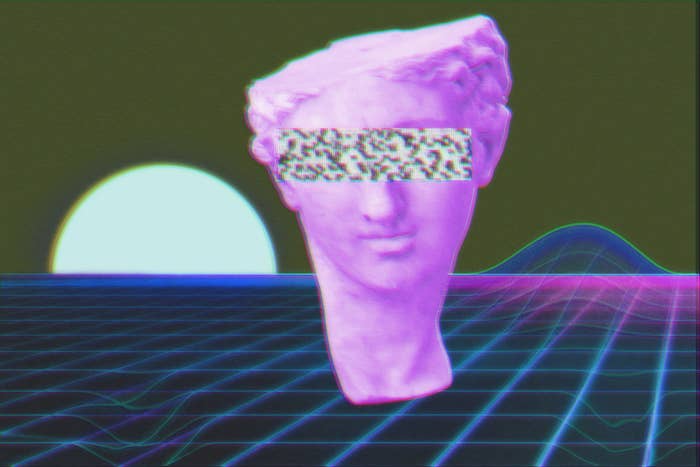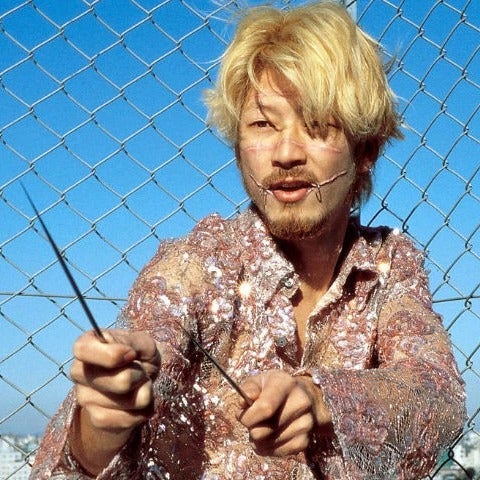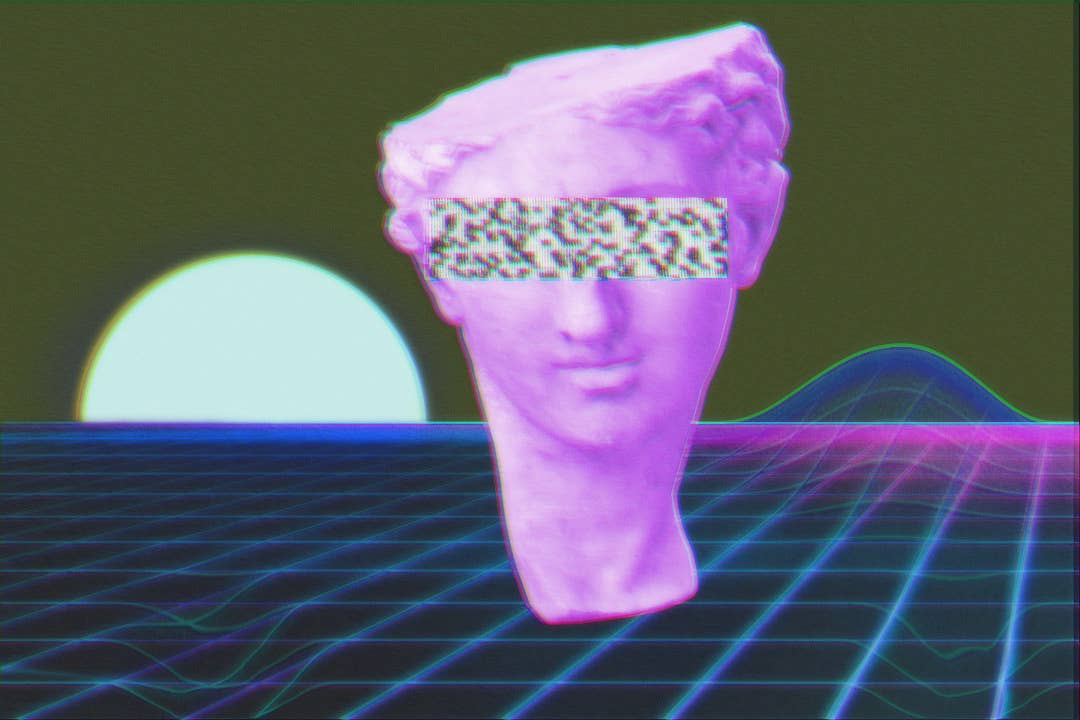
Right at the end of 2013, Thump published an essay titled “Is Vaporwave The Next Seapunk?” Michelle Lhooq writes in the article that “Seapunk started as a joke and ended that way,” adding that vaporwave, a movement a little less focused on seashells and a little more interested in innovating musically, won’t. Three years on, it’s still not entirely clear whether vaporwave will, in fact, end, even if it is starting to become a joke to an increasing number of people.
Internet born micro-genres don’t exactly have a good track record, often occupying small graveyards in the backwoods of Bandcamp. Cloud rap slowly faded away, chillwave slumped to the floor like a top-heavy Jenga tower, and witch house just vanished in a manner that made way too much sense considering its mysterious gothic aesthetic. Vaporwave, however, despite how hard many have tried to kill it off with movements like “hard vapour,” refuses to to accept what some consider its long overdue fate.
With a history pre-dating its initial boom in 2011 through to 2013, the actual birth of vaporwave as a scene and a micro-genre isn’t entirely clear. Floral Shoppe, the seminal 2011 album from Ramona Andra Xavier under the alias of Macintosh Plus, is often the first thing that comes to mind when vaporwave is brought up, but in reality, the genre dates a bit further back. Stemming from the hypnagogic pop movement that DIY artists like James Ferraro and the vastly overlooked 18 Carat Affair birthed less than a decade ago, vaporwave took a long time to get where it is now.
Many of the artists behind the most influential and inventive vaporwave releases have moved on to bigger and quite often better things. Saint Pepsi has morphed into the revivalist pop of Skylar Spence, Ramona Xavier is exploring her full capabilities as a producer with Vektroid, and Telepath and HKE, known collectively as 2814, are ditching the sample-upon-sample framework that came before them. In light of all this, it’s surprising, then, that the scene is still going strong, despite the abandonment of its founders.
Beer on the Rug, one of the labels responsible for some of the biggest and most famous vaporwave releases, has recently shifted their focuses to a more experimental sound. Releasing projects that lean more towards darkwave, ambient, and leftfield beat music, the label has sought to evolve. Dream Catalogue is another one of the premier labels that remains innovative—they operate primarily through Bandcamp.
With trends such as Simpsonswave—a meme that pairs more accessible vapor-like music with digitally manipulated footage from The Simpsons—gaining a lot of attention long after vaporwave’s heyday, why is it that people are ignoring what made vaporwave so exciting to begin with? Vaporwave, a scene that repurposed the remnants of the past and borrowed from hauntology à la Boards of Canada, has become a repurposed corpse itself. Abandoning the punk ethos and frequent conceptual leanings in favor of comedic “AESTHETIC” videos shared on YouTube and Facebook, vaporwave has finally reached either its logical conclusion or full maturity by becoming exactly what it shouldn’t.
At its core, vaporwave was a punk movement. It was the punk of the ‘10s, and now that it’s decidedly unpunk, it’s about time everyone stops Green Daying the hell out of it. Thanks to releases that took a more experimental stance and stood out more, vaporwave carved out a very specific niche that united artists all over the world. Refusing to be as unified as witch house and chillwave before it, using unclearable samples, and generally reinventing plunderphonics for a new audience, vaporwave was, and in some cases still is, one of the most compelling DIY movements to stem from the internet.
These days, it has devolved into sub-Reddits debating what is and what isn’t vaporwave, which completely misses the point. Stylistically, vaporwave is seemingly only pinned down by aesthetic and the use of samples rather than a specific sound or feel. That signature retro-inspired look that quite often featured Japanese text, glitch art, renaissance sculptures, lo-fi cyberpunk visuals, video game sprites, early web design, outdated CGI, and a lot of pink and purple, isn’t as prominent as it once was.
But what caused this shift to begin with? HKE, the founder of Dream Catalogue and an artist himself, thinks “the shift began as early as people like myself, Telepath and all the others who came up with us on Dream Catalogue coming into the scene back in late 2013 and early 2014, really.”
“What we were doing was always a bit different from what was and generally still is commonly known as vaporwave and really we were just paying attention to ourselves and the stuff we were posting on Soundcloud and Bandcamp, and not very much to what had come before. But as time went on we all evolved as artists in our own individual ways to the point where the connection to vaporwave is almost non-existent now.”
One of HKE's many aliases, in this case Sandtimer, saw him releasing an album called Vaporwave Is Dead in 2015, featuring industrial, pulsating, and downright aggressive songs void of all the signature sounds of earlier Dream Catalogue releases. The album features a track titled “An Ode To Vaporwave (RIP),” and its dark ambience plays out like an old man revisiting bittersweet memories.
“[The] initial goal wasn't to ever make it a strictly vaporwave label,” HKE explains, “and that just became the tag and association over time despite the fact many artists on the label were never even making vaporwave-like music in the first place.”
“That's ultimately why I released Vaporwave Is Dead—it was to gain a sense of liberation from what I felt were becoming the tired cliches of vaporwave,” he says. “I felt a lot of artists in the vaporwave scene, including myself, were in danger of falling into safe and boring formulas of repeating the same ideas over and over.”
When vaporwave first surfaced, many were quick to comment on the aesthetic aspects that came to define the scene—the sleek corporate-inspired sheen and sleaze, the garish colors and dated logos—but what really stuck was the music. The stylistic roots of the genre can be traced as far back as the 1970s and 1980s with releases like Shigeo Sekito’s Vol. II, which has been sampled in a few vaporwave releases alongside an interpolation from Mac DeMarco, but the late ‘00s is when it really started to take shape. Borrowing generously from obscure ‘80s releases artistically, the chopped and screwed dream-like sounds that made up the majority of the landmark releases were, at the time, fresh.
Daniel Lopatin, best known for his work as Oneohtrix Point Never, quietly uploaded a number of hypnotic loops to YouTube under the guise of sunsetcorp back in 2009. The tracks eventually surfaced on a full album with Chuck Person’s Eccojams Vol. 1, and as far as plunderphonics goes, it was one of the laziest releases to adopt the approach. However, that laziness worked, and the album became one of the building blocks for what would eventually become vaporwave.
It’s a minimal release that still lends itself well to repeat listens, but when stacked up against what artists in the vaporwave scene would eventually put out on Bandcamp, it is rudimentary. He would later go on to expand upon some of the vaporwave-like concepts further with R Plus Seven and last year's Garden of Delete, albeit with considerably more grandeur and grace.
View this video on YouTube
On the other side of the vaporwave spectrum was Far Side Virtual by experimental artist James Ferraro, who previously made a name with a number of obtuse and scruffy lo-fi electronic albums. With Far Side Virtual, Ferraro tidied up his sound considerably, and the resulting album was highly divisive. Gaining praise from the likes of The Wire and Pitchfork, the album was essentially a 40-minute ringtone.
Echoing the artificial nature of corporate training videos and slightly distressing elevator music, Far Side Virtual represented what vaporwave could be when it didn’t rely on samples, even if it was far shinier and hyperactive than what was to follow its release. It was hilariously gaudy and a little freaky with its musical uncanny valley approach, but there’s something fascinating about it.
Somewhere between those two extremes was where vaporwave really shined, with releases like Saint Pepsi’s Hit Vibes, ESPRIT’s Virtua.zip, Blank Banshee’s 0, and 2814’s Birth of a New Day. The common thread between albums like these is that they all bear little resemblance to what people called vaporwave early on, aside from their visual identity, raising the question of what vaporwave even was to begin with.
For many, vaporwave was just a visual set of aesthetics and a vibe. The visual aspect formed faster than the sound, resulting in releases that look the same but fail to form a sonically cohesive whole. Many online sub-Reddits and those on 4chan have attempted to invent sub-genres within vaporwave itself, but most faded away, and many didn’t make sense to begin with. There will always be hardcore fans compiling lists of their favorite, slightly different strains of vaporwave, but for those less interested in the specifics this is merely pedantry getting in the way of music.
As a funhouse mirror of pop-culture, vaporwave brought a crowd together. That same crowd eventually abandoned it, because the mirror wasn’t needed anymore—vaporwave had become a part of pop culture.
View this video on YouTube
Nostalgia is more in demand than ever, so it makes sense that vaporwave, a net-genre employing nostalgia frequently great effect, has become something that people are nostalgic about.
As the most successful attempt to create a new micro-genre of music via the internet, vaporwave is beloved by many. Even when memes come into the equation, there’s rarely a sense of mean-spiritedness. Started as an outsider movement with almost zero pop appeal, the online community eventually fostered vaporwave into something so singular that people couldn’t fall under its spell.
Now, vaporwave is beginning to repeat itself. Artists once thought as geniuses in the net-genre landscape are portrayed as memes. Just like chillwave before it, the whole movement consisted of artists preying upon a false sense of nostalgia. That’s why, during a time in which everything is being rebooted or revived and Netflix’s Stranger Things is the most talked about serialized show, vaporwave has persisted despite a lot of the big talent moving on so long ago.
There’s a culture around vaporwave now, regardless of whether people think it’s dead or not. Ramona Xavier, best known for her landmark Macintosh Plus album Floral Shoppe and her work as Vektroid, definitely has a more positive outlook on vaporwave than many others. “The fact that there's an actual culture building around the scene is pretty amazing,” she tells me over Twitter DM. “I can’t take any credit for that,” she stresses, despite people crediting vaporwave’s prominence to her extensive work. “People have put in so much elbow grease and most of it happened while I was completely MIA.”
“I'm definitely not an authority on whether vaporwave is 'punk' or not, but folks are launching their own labels, getting their work pressed/duped on a totally independent level--maybe that really does count?” Many of those artists that initially jumped on the bandwagon in the wake of Floral Shoppe, have for the most part, faded into obscurity. Ramona, and countless others, however, have continued to make music that refuses to fit into any clear labels, but is still at home in the general vaporwave community.
But at the same time, that very community has held back artists that try to be anything more. Macintosh Plus essentially became a meme, far bigger than the community itself, and while that’s brought more attention to her subsequent output, it’s also brought expectations, too. There are countless parody albums of Floral Shoppe, to the point in which there are even full Bandcamp pages dedicated to these innocuous releases.
Speaking about the community as a whole, she says that it’s “hella exciting to see” the culture around vaporwave build, but it’s not necessarily something she feels comfortable being too deeply involved with. “I guess I've just been too fixated on figuring out how to get myself out of the box that is Macintosh Plus. It's gotten difficult to tell if people are laughing with me or at me when it comes to that one, and frankly I can't blame people for falling into the latter category.”
To those not constantly checking the vaporwave charts on Bandcamp, vaporwave is a big joke. Users of the various vaporwave sub-Reddits will always take it very seriously for the most part, but even there people are discussing whether or not vaporwave is still going strong. “I don't think the 'spirit' of it died at all, I think it's just too big now for a lot of us to be able to look at [it] as casually as we once did, and for me that led to a long period of creative lockjaw,” Ramona says of the continued growth and persistence of vaporwave.
She remains positive in light of this, though, saying, “The fact that everything we did is establishing some level of permanence gives me a lot of hope. Macintosh Plus might end up being a flash in the pan at the end of the day, but I don’t think the scene itself is going to suffer the same fate.”




